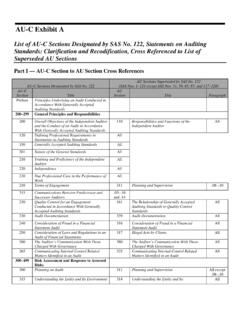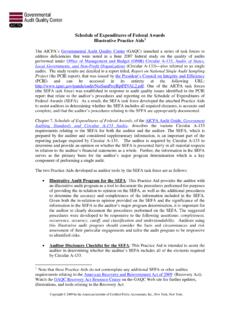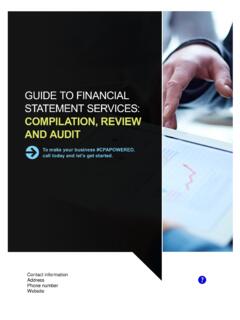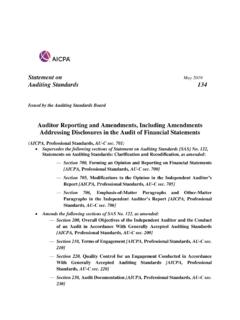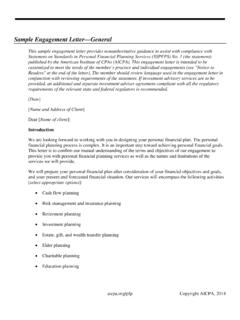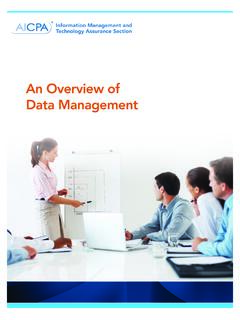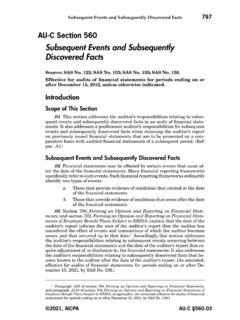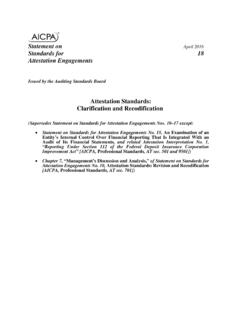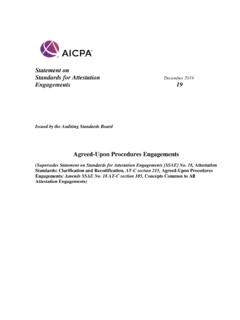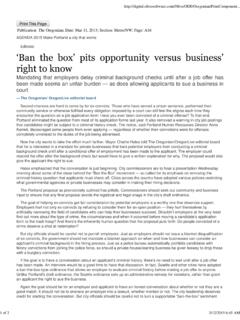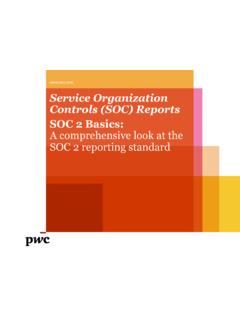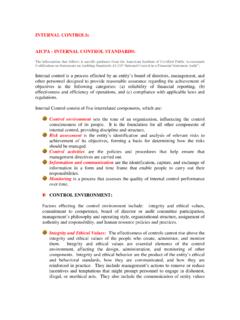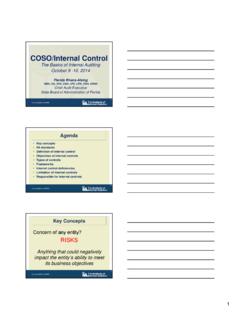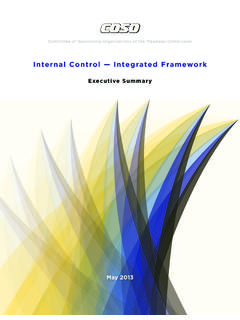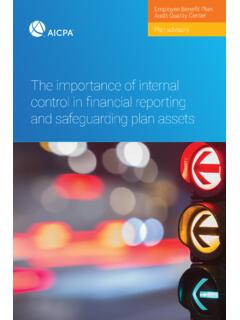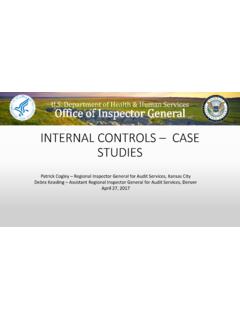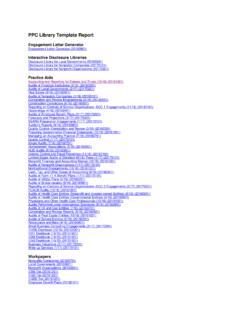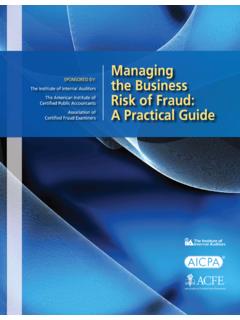Transcription of Understanding the Entity and Its Environment and ... - AICPA
1 Understanding the Entity and Its Environment291AU-C Section 315 Understanding the Entity and Its Environmentand Assessing the Risks of MaterialMisstatementSource: SAS No. 122; SAS No. 128; SAS No. 130; SAS No. 134; SASNo. for audits of financial statements for periods ending on orafter December 15, 2012, unless otherwise July 2020, the Auditing Standards Board issued Statement on AuditingStandards (SAS) No. 142,Audit Evidence, which contains amendments to amendments are effective for audits of financial statements for periodsending on or after December 15, 2022, and can be viewed in appendix B ofsection 500 until the effective date, when they will be applied to this of This section addresses the auditor's responsibility to identify and as-sess the risks of material misstatement in the financial statements throughunderstanding the Entity and its Environment , including the Entity 's section is effective for audits of financial statements for periodsending on or after December 15, objective of the auditor is to identify and assess the risks of ma-terial misstatement, whether due to fraud or error, at the financial statementand relevant assertion levels through Understanding the Entity and its envi-ronment, including the Entity 's internal control .
2 Thereby providing a basis fordesigning and implementing responses to the assessed risks of material purposes of generally accepted auditing standards (GAAS), the fol-lowing terms have the meanings attributed as follows: 2021, AICPAAU-C Assessment and Response to Assessed by management, explicit or otherwise,that are embodied in the financial statements as used by the au-ditor to consider the different types of potential misstatementsthat may risk resulting from significant conditions, events,circumstances, actions, or inactions that could adversely affect anentity's ability to achieve its objectives and execute its strategiesor from the setting of inappropriate objectives and process effected by those charged with gover-nance, management, and other personnel that is designed to pro-vide reasonable assurance about the achievement of the Entity 'sobjectives with regard to the reliability of financial reporting, ef-fectiveness and efficiency of operations, and compliance with ap-plicable laws and regulations.
3 internal control over safeguard-ing of assets against unauthorized acquisition, use, or dispositionmay include controls relating to financial reporting and opera-tions financial statement assertion that has areasonable possibility of containing a misstatement or misstate-ments that would cause the financial statements to be materiallymisstated. The determination of whether an assertion is a rele-vant assertion is made without regard to the effect of internalcontrols. (Ref: par..A136)Risk assessment audit procedures performed toobtain an Understanding of the Entity and its Environment , in-cluding the Entity 's internal control , to identify and assess therisks of material misstatement, whether due to fraud or error, atthe financial statement and relevant assertion identified and assessed risk of material mis-statement that, in the auditor's professional judgment, requiresspecial audit Assessment Procedures and Related auditor should perform risk assessment procedures to provide abasis for the identification and assessment of risks of material misstatementat the financial statement and relevant assertion levels.
4 Risk assessment pro-cedures by themselves, however, do not provide sufficient appropriate audit ev-idence on which to base the audit opinion. (Ref: par..A1 .A5).06 The risk assessment procedures should include the of management, appropriate individuals within the in-ternal audit function (if such function exists), others within theentity who, in the auditor's professional judgment, may have in-formation that is likely to assist in identifying risks of materialmisstatement due to fraud or error (Ref: par..A6 .A13) procedures (Ref: par..A14 .A17) and inspection (Ref: par..A18)1 This section recognizes the definition and description ofinternal controlcontained inInter-nal control Integrated Framework, published by the Committee of Sponsoring Organizations of theTreadway 2021, AICPAU nderstanding the Entity and Its Environment293[As amended, effective for audits of financial statements for periods ending onor after December 15, 2014, by SAS No.]
5 128.].07 The auditor should consider whether information obtained from theauditor's client acceptance or continuance process is relevant to identifyingrisks of material the engagement partner has performed other engagements for theentity, the engagement partner should consider whether information obtainedis relevant to identifying risks of material planning, the auditor should consider the results of the assess-ment of the risk of material misstatement due to fraud2along with other in-formation gathered in the process of identifying the risks of material the auditor intends to use information obtained from the audi-tor's previous experience with the Entity and from audit procedures performedin previous audits, the auditor should determine whether changes have oc-curred since the previous audit that may affect its relevance to the currentaudit. (Ref: par..A19 .A21).11 The engagement partner and other key engagement team membersshould discuss the susceptibility of the Entity 's financial statements to materialmisstatement and the application of the applicable financial reporting frame-work to the Entity 's facts and circumstances.
6 The engagement partner shoulddetermine which matters are to be communicated to engagement team mem-bers not involved in the discussion. (Ref: par..A22 .A24) Understanding the Entity and Its Environment , Includingthe Entity s internal ControlThe Entity and Its Environment (Ref: par..A25).12 The auditor should obtain an Understanding of the industry, regulatory, and other external factors, includ-ing the applicable financial reporting framework. (Ref: par..A26 .A30) nature of the Entity , includingi. its operations;ii. its ownership and governance structures;iii. the types of investments that the Entity is making andplans to make, including investments in entities formedto accomplish specific objectives; andiv. the way that the Entity is structured and how it is financed,to enable the auditor to understand the classes of transactions,account balances, and disclosures to be expected in the financialstatements. (Ref: par..A31.)
7 A35) Entity 's selection and application of accounting policies, in-cluding the reasons for changes thereto. The auditor should eval-uate whether the Entity 's accounting policies are appropriate forits business and consistent with the applicable financial reporting2 See section 240,Consideration of Fraud in a Financial Statement Audit. 2021, AICPAAU-C Assessment and Response to Assessed Risksframework and accounting policies used in the relevant industry.(Ref: par..A36) Entity 's objectives and strategies and those related businessrisks that may result in risks of material misstatement. (Ref: .A43) measurement and review of the Entity 's financial perfor-mance. (Ref: par..A44 .A49)The Entity s internal auditor should obtain an Understanding of internal control rele-vant to the audit. Although most controls relevant to the audit are likely torelate to financial reporting, not all controls that relate to financial reportingare relevant to the audit.
8 It is a matter of the auditor's professional judgmentwhether a control , individually or in combination with others, is relevant to theaudit. (Ref: par..A50 .A75)Nature and Extent of the Understanding of Relevant obtaining an Understanding of controls that are relevant to theaudit, the auditor should evaluate the design of those controls and determinewhether they have been implemented by performing procedures in addition toinquiry of the Entity 's personnel. (Ref: par..A76 .A78)Components of internal auditor should obtain an Understanding ofthe control Environment . As part of obtaining this Understanding , the auditorshould evaluate , with the oversight of those charged with gover-nance, has created and maintained a culture of honesty and eth-ical behavior strengths in the control Environment elements collectivelyprovide an appropriate foundation for the other components ofinternal control and whether those other components are not un-dermined by deficiencies in the control Environment .
9 (Ref: .A89).16 The Entity 's risk assessment auditor should obtain an un-derstanding of whether the Entity has a process business risks relevant to financial reporting objec-tives, the significance of the risks, the likelihood of their occurrence, about actions to address those risks.( .A91).17If the Entity has established a risk assessment process (referred tohereafter as theentity's risk assessment process), the auditor should obtain anunderstanding of it and the results thereof. If the auditor identifies risks ofmaterial misstatement that management failed to identify, the auditor shouldevaluate whether an underlying risk existed that the auditor expects wouldhave been identified by the Entity 's risk assessment process. If such a risk ex-ists, the auditor should obtain an Understanding of why that process failed toidentify it and evaluate whether the process is appropriate to its circumstancesor determine if a significant deficiency or material weakness exists in internalcontrol regarding the Entity 's risk assessment 2021, AICPAU nderstanding the Entity and Its the Entity has not established such a process or has an ad hoc pro-cess, the auditor should discuss with management whether business risks rel-evant to financial reporting objectives have been identified and how they havebeen addressed.
10 The auditor should evaluate whether the absence of a docu-mented risk assessment process is appropriate in the circumstances or deter-mine whether it represents a significant deficiency or material weakness in theentity's internal control . (Ref: par..A92).19 The information system, including the related business processes rele-vant to financial reporting and communication. The auditor should obtain anunderstanding of the information system, including the related business pro-cesses relevant to financial reporting, including the following classes of transactions in the Entity 's operations that are sig-nificant to the financial procedures within both IT and manual systems by whichthose transactions are initiated, authorized, recorded, processed,corrected as necessary, transferred to the general ledger, and re-ported in the financial related accounting records supporting information and spe-cific accounts in the financial statements that are used to initiate,authorize, record, process, and report transactions.
